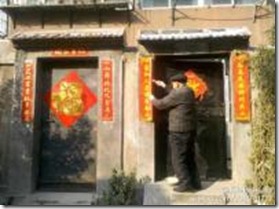Kita wrote from China a couple of days ago about how she hung up banners with Spring Couplets on them around her door for the Chinese New Year :
"Tonight is Chuxi. (Chinese New Year’s Eve.) This afternoon, my grandpa and I pasted up spring couplets.
My grandpa makes the paste with flour. We mix flour and water and then boil them together. It becomes very sticky. Then we paste up the banners. Using this self-made paste to paste up spring couplets is better than glue.
The banners were written by people who are good at calligraphy. People used to write them personally, and the banners used to be black characters written on red paper. Nowadays, people just print them, and sometimes they use gold characters.
The Spring Couplet is pasted up on both sides of the door. A horizontal scroll bearing an inscription, usually an auspicious phrase is put above the gate (or door).
This year, my family’s spring couplet is:
国泰民安神州庆 (Peace and Prosperity, China Celebrates.)
家和人寿满园春 (Family Harmony, People Healthy and Long Life, Gardens Full of Spring)
恭贺新春 (Happy Spring Festival)
The Spring Couplet is composed of two contrasting sentences. The sentences in the Spring Couplet are like ying and yang.
[The couplets seem to be a play on words done with Chinese characters in a way that cannot be done with the Roman alphabet in English. Here’s the example Kita gave…]
墨 (ink) and 泉 (spring) are a contrast:
Because the top part of the Chinese character 墨 (ink) is 黑 (black), and the top part of 泉 (spring) is 白 (white). 黑 (black) and 白 (white) are contrasts. Also, the bottom part of 墨 (ink) is 土 (soil), and the bottom part of 泉 (spring) is 水 (water). Both 土 (soil) and 水 (water) belong to The Five Elements [and they’re contrasts].
There are also some rules about sounds in couplets. Chinese has different tones, usually we say there are four tones. Characters have two classifications: 平 and 仄 (level and oblique tones). This classification is also used in ancient poetry.
The first tone belongs to 平 (level), and the other tones belong to 仄 (oblique). In couplets, you have to avoid only using 平 or 仄 tones. They should be used alternately. Also, you can’t have only one 平 (level) word in a sentence."
You can read more about Spring Couplets here and about The Four Tones here.
Many thanks to Kita for sharing these traditions with us!
Happy New Year!
Mama Lisa
This article was posted on Sunday, February 10th, 2013 at 3:41 pm and is filed under China, Chinese, Chinese New Year, Countries & Cultures, Holidays Around the World, Languages, Spring Couplets. You can follow any responses to this entry through the RSS 2.0 feed. You can skip to the end and leave a response. Pinging is currently not allowed.
Leave a Reply

























